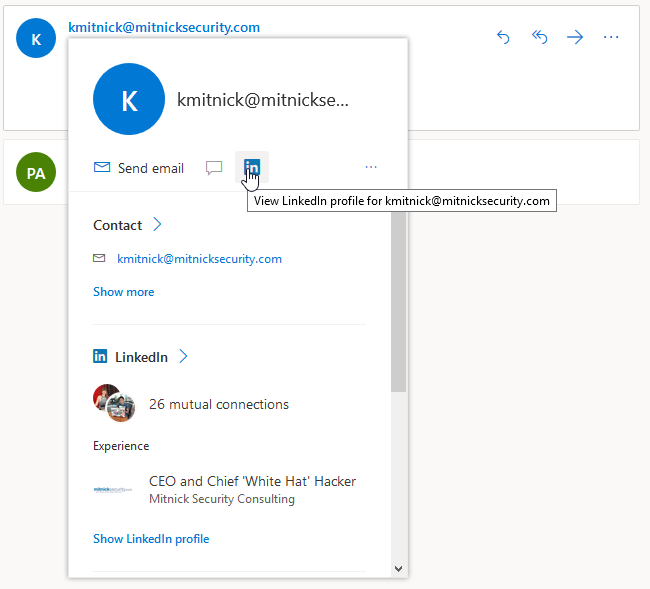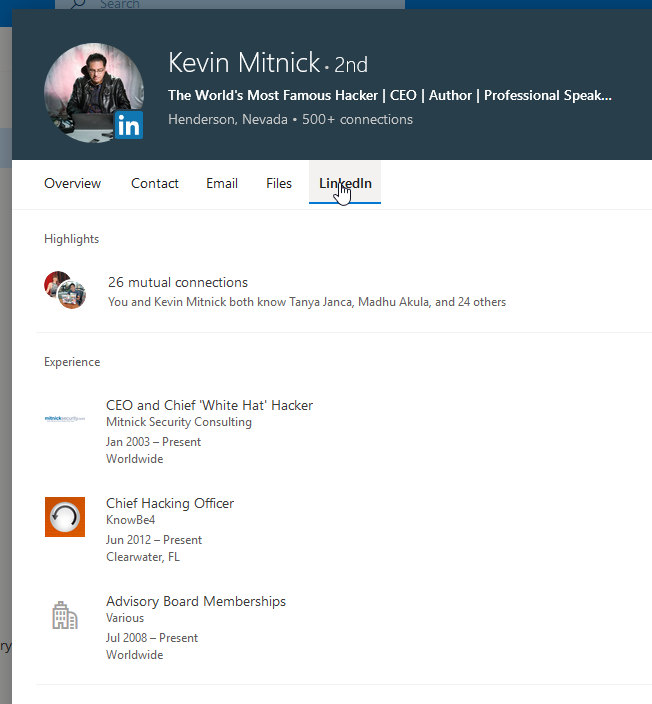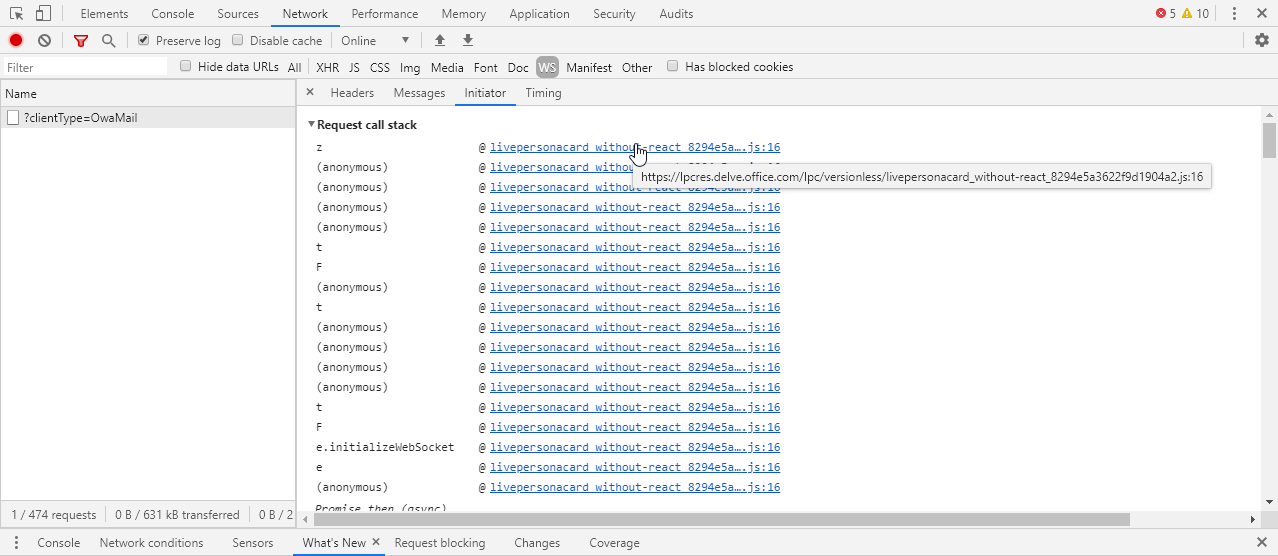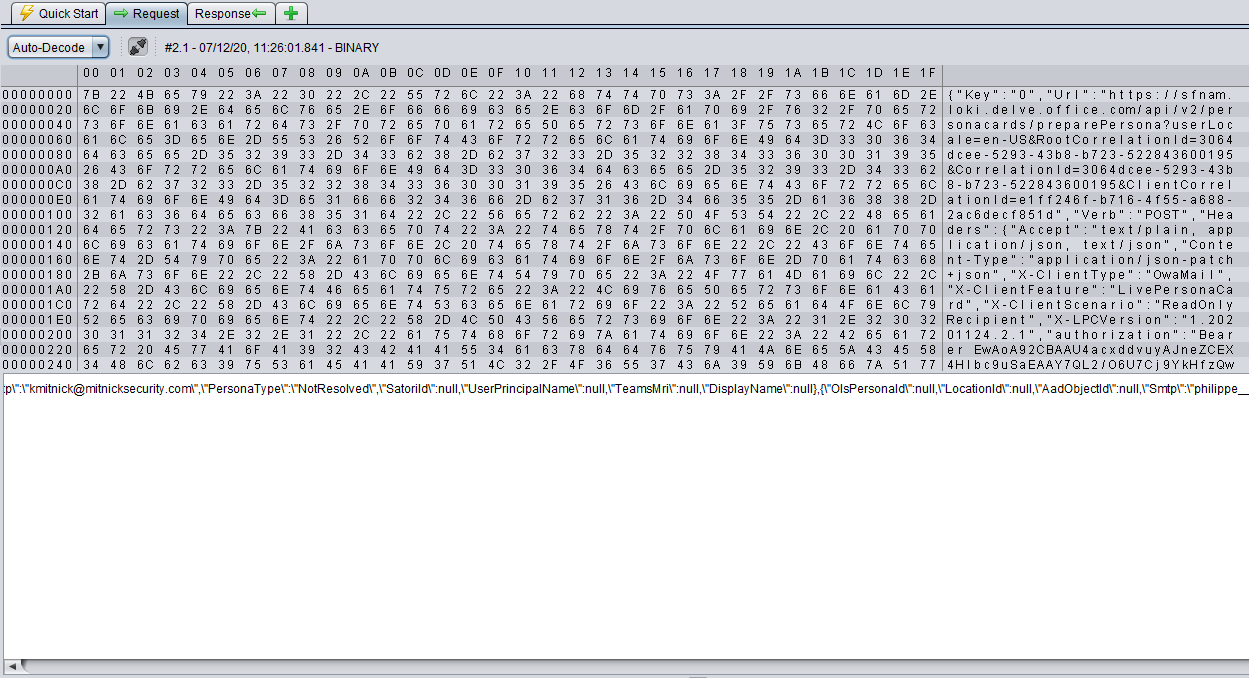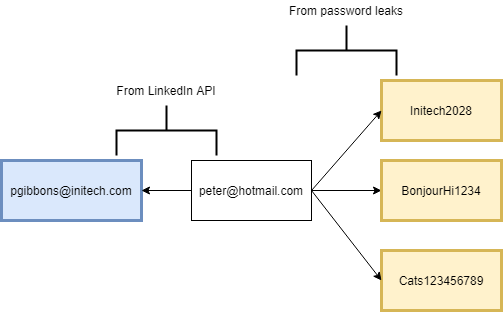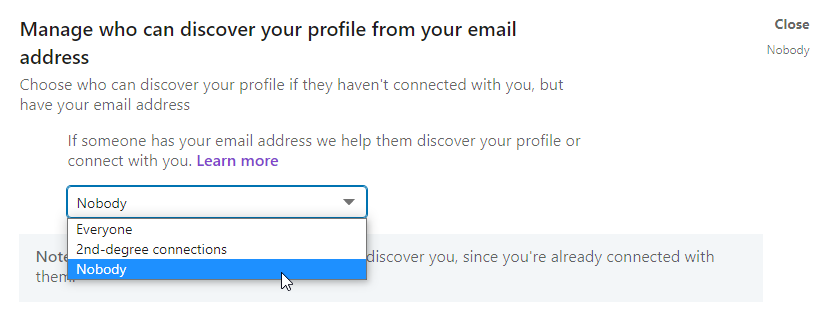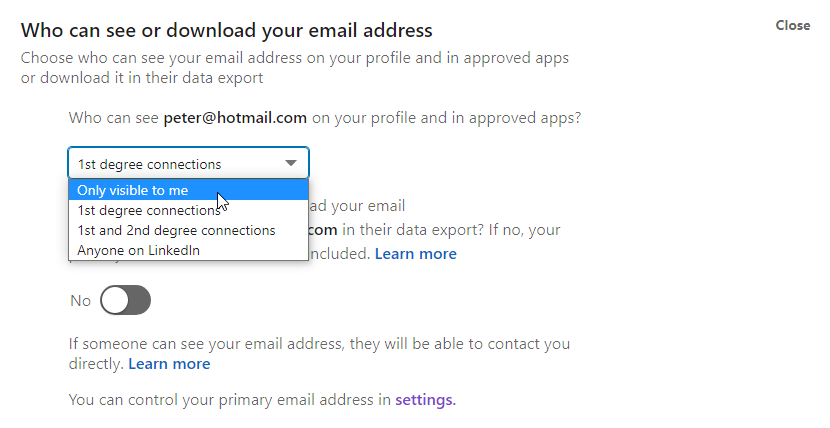Author: Philippe Arteau
In this blog post, we will look at the privacy issues with some of LinkedIn’s external APIs. We will demonstrate how it is possible, with an email address, to find its associated LinkedIn profile. It is also possible from a LinkedIn profile to do the reverse path and find a person’s email address. To execute this deanonymization attack, documented features, like LinkedIn’s integration with Outlook and YahooMail, are used.

This short article is not exactly about a vulnerability. It is about documenting risks that LinkedIn is aware of. Our goal is to educate users about it. Meanwhile, we are going to go over technical details that are not explicitly described in LinkedIn’s online documentation and terms and conditions.
The impact in a nutshell: Your LinkedIn email and phone number can be found by users beyond your first-degree connections.

In this blog post, we will look at the privacy issues with some of LinkedIn’s external APIs. We will demonstrate how it is possible, with an email address, to find its associated LinkedIn profile. It is also possible from a LinkedIn profile to do the reverse path and find a person’s email address. To execute this deanonymization attack, documented features, like LinkedIn’s integration with Outlook and YahooMail, are used.
This short article is not exactly about a vulnerability. It is about documenting risks that LinkedIn is aware of. Our goal is to educate users about it. Meanwhile, we are going to go over technical details that are not explicitly described in LinkedIn’s online documentation and terms and conditions.
The impact in a nutshell: Your LinkedIn email and phone number can be found by users beyond your first-degree connections.
The Feature
Looking at the source code highlighted by Chrome, we found the code handling new requests and responses. We can see in the onMessage callback handler, presented in the code snippet below, that the message received is converted to a UInt8 array and decompressed using the inflateRaw method from the module Pako. Pako is a library that supports the LZip compression algorithm. The InflateRaw() function, compared to the inflate() function, is using LZip compression without a metadata header that contains filename and modification date.
}, e.prototype.onMessage = function (e) {
var t = this;
this.inflateData(e.data, function (n) {
try {
t.setServerPingTimerIfEnabled();
var r = JSON.parse(n), o = k()(r.Key, 10);
if (-1 === o) return;
if (r.Headers = r.Headers && q(r.Headers), o in t.activeRequestsMap) {
var i = t.activeRequestsMap[o];
i && (clearTimeout(i.timeout), setTimeout(function () {
return i.onSuccess(r, e.timeStamp)
}, 0)), delete t.activeRequestsMap[o]
} else t.logError("WebSocket-onMessage-UnableToFindResponseKey", {Key: o.toString()})
} catch (e) {
t.logError("WebSocket-onMessage-ReceiveFailure", {Exception: e.message})
}
})
}, e.prototype.inflateData = function (e, t) {
return G(this, void 0, void 0, function () {
var n, r, o;
return W(this, function (i) {
switch (i.label) {
case 0:
return this.compressionDisabled ? (t(e), [3, 4]) : [3, 1];
case 1:
return i.trys.push([1, 3, , 4]), [4, this.getPako()];
case 2:
return n = i.sent(), r = n.inflateRaw(new Uint8Array(e), {to: "string"}), t(r), [3, 4];
case 3:
return o = i.sent(), this.logError("WebSocket-inflateData-PakoInflateFailure", {Exception: o}), t(""), [3, 4];
case 4:
return [2]
}
})
})Once we know the encoding, we can either hook the JavaScript method where the encoding/decoding occurs, but this can be difficult to maintain if the page refreshes or if the page is doing requests during page initialization. We opted for the creation of a simple ZAP plugin that would decode the messages, both requests and responses. The ZAP Auto-Decode detailed view (see screenshot below) decompresses a message if it matches the LZip or GZip format.
There are a few requests made for this LinkedIn endpoint. We can see, in the code snippet below, the request that is responsible for loading a LinkedIn profile in the JSON message with the path /api/v1/linkedin/profiles/full. Many requests to sfnam.loki.delve.office.com are HTTP requests wrapped in a JSON format. The JSON property Url is analog to the HTTP path, and all headers are under the property Headers. We tested the request directly in HTTP, without WebSocket connection, and the same features were accessible. JSON messages over WebSocket communication is not the only open channel.
{
"Key": "15",
"Url": "https://sfnam.loki.delve.office.com/api/v1/linkedin/profiles/full?PersonaDisplayName=Peter%20Gibbons&ExternalPageInstance=332c2687-71f7-49df-8b7c-b2402ccbf473&UserLocale=en-US&OlsPersonaId=&AadObjectId=&Smtp=kmitnick%40mitnicksecurity.com&UserPrincipalName=&PersonaType=User&RootCorrelationId=2933990e-0cc2-4406-8103-0cba160e7047&CorrelationId=2933990e-0cc2-4406-8103-0cba160e7047&ClientCorrelationId=0d3bf626-18d0-46bf-8ce4-667b7bb485b4",
"Verb": "GET",
"Headers": {
"Accept": "text/plain, application/json, text/json",
"X-ClientType": "OwaMail",
"X-ClientFeature": "LivePersonaCard",
"X-LPCVersion": "1.20201124.2.1",
"authorization": "Bearer EwAYA9[...]",
"X-HostAppCapabilities": "{}"
}We replaced the email address with another one from which we do not have any mail in our inbox. The server gave the JSON message shown below, which contains the complete LinkedIn profile of the user related to that address.
{
"Key": "4",
"StatusCode": 200,
"ReasonPhrase": "OK",
"Headers": {
"X-WebSocketCorrelationId": "9cb14592-5728-******",
"Cache-Control": "no-store",
"Server": "Microsoft-HTTPAPI/2.0",
"X-BEServer": "_Loki_10716",
"X-DataCenter": "PROD_NORTHCENTRALUS",
"X-ServerVersion": "0.20201202.4.1",
"X-Content-Type-Options": "nosniff",
"X-TokenTtl": "86390",
"X-InboundDuration": "14",
"X-CorrelationId": "9cb14592-5728-47c5- ******,
"Access-Control-Allow-Origin": "https://sfnam.loki.delve.office.com",
"Access-Control-Allow-Credentials": "true",
"Access-Control-Expose-Headers": "X-ServerVersion,X-InboundDuration,X-BEServer,X-TokenTtl,X-SocialDistance,X-CorrelationId,X-DataCenter,x-azure-ref,Retry-After",
"Date": "Mon, 07 Dec 2020 16:26:01 GMT"
},
"Body": "<<JSON escaped string>>"
}{\"resultTemplate\":\"ExactMatch\",\"bound\":true,\"bindUrl\":\"https://login.live.com/accountbind.srf?provider=linkedin.com&redirect_uri=https://loki.delve.office.com/linkedInAuthRedirect.aspx&client_id=000000004C1E916B&dualbind=1&mkt=en-US&external_app=Owa&dualbindmobile=True\",
\"persons\":[{\"id\":\"urn:li:person:DgEN90FFXdpXh-OCiFTGl3l0pTo6d4ub6h19lWlc7mE\",\"displayName\":\"Kevin Mitnick\",\"headline\":\"The World's Most Famous Hacker | CEO | Author | Professional Speaker\",\"companyName\":\"Mitnick Security Consulting\",\"location\":\"Henderson, Nevada, United States\",
\"photoUrl\":\"https://media.licdn.com/dms/image/C4E03AQEKmI4XcvU8nQ/profile-displayphoto-shrink_800_800/0?e=1613001600&v=beta&t=o8EaQb4TeZn9JhUOTJJOS3PA9uzaewnHWO7n7nJNDfw\",\"linkedInUrl\":\"https://www.linkedin.com/in/kevinmitnick\",
//... JSON messages also include schools, work experience, company details,
}The Issue
Privacy
Many malicious actors will find this information incredibly valuable. Such feature allows deanonymizing LinkedIn users in both small and large scales. For example, we could target an anonymous WordPress blogger and using the technique presented in the previous blog, we could easily find the email of that blogger. All an attacker has left to do is to transmit the same WebSocket request shown previously with the email to deanonymize the individual.
{
"Url": "https://sfnam.loki.delve.office.com/api/v1/linkedin/profiles/full? [...] &Smtp=<<test.email@company.com>>&UserPrincipalName=&PersonaType=User [...]",
[...]
}Credential Stuffing
Password leaks are rarely including employee emails. More than 85 % of leaked passwords are associated with personal email addresses using public providers. This conclusion is based on the analysis of 2.6 billion unique email addresses with known information leaks provided by Flare Systems. The top domains of such providers are gmail.com, hotmail.com, yahoo.com and outlook.com. However, because LinkedIn profiles are tied to companies, it is possible to link these personal email addresses (peter@hotmail.com) to corporate emails (pgibbons@initech.com) based on company email formats.
Phishing
Finally, tricking employees to click on malicious links using deceptive emails (known as phishing) can be done via platforms outside of corporate environments, such as personal inboxes. Employees could receive fishing links on their personal email clients, a channel that cannot be monitored by corporate organizations to identify and mitigate initial device compromises.
Potential Defense
It is worth mentioning that the LinkedIn APIs are throttling the number of queries to the service sfnam.loki.delve.office.com. Users can make a thousand requests every 2 days. This is likely meant to slow down data harvesters.
In general, information lookups using email addresses should be avoided. Some marketers and recruiters are getting more aggressive when it comes to collecting personal information.
From the user’s perspective, three settings can be changed.
1. Profile visibility off LinkedIn: Manage Your Profile’s Visibility On and Off LinkedIns and Off-LinkedIn Visibility
2. Manage who can discover your profile from your email address
3. Refuse connections with users you do not know or hide contact information from everybody
Final Thoughts
References
- Similar issue on Facebook
https://web.archive.org/web/20161226011136/dawgyg.com/2016/12/21/disclosing-the-primary-email-address-for-each-facebook-user/ - Announcement about the integration to YahooMail
https://blog.linkedin.com/2015/04/16/yahoo-mail - LinkedIn Help: Profile visibility off LinkedIn
https://www.linkedin.com/help/linkedin/answer/83634 - LinkedIn Help: Off-LinkedIn Visibility
https://www.linkedin.com/help/linkedin/answer/79854
